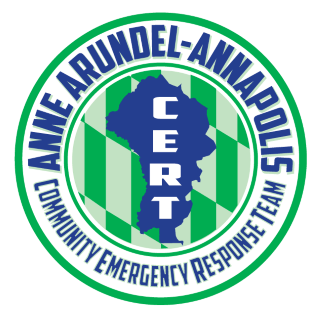AAACERT hosted its first online training via Zoom on March 25, 2020, on the topic of emergency sanitation and hygiene. President Bruce Morgenstern welcomed participants and explained that AAACERT is using this interactive video platform to practice safe social distancing during the pandemic of the novel coronavirus that causes COVID-19.
The presenter, Public Information Officer Jonathan Hutson, thanked our corporate donors: Bass Pro Shops and Cabela’s, makers of the Cabela’s Easy Up privacy and shower shelter and Camp Commode camping toilet; home improvement store Home Depot; Rambler Wheels, makers of the Wild Stool emergency bucket toilet seat; and Lavario, makers of the Lavario off-grid, portable washing machine.
Hutson, who had been planning a training on emergency sanitation and hygiene for several months, and adapted some of the material in the context of the COVID-19 pandemic, asked participants to imagine:
A hurricane knocks out the power grid for
three weeks. Flood waters compromise public sanitation and water treatment
facilities. When you flip the light switch, nothing happens. Your toilet won’t
flush. You can’t get clean water from your taps. Public health authorities warn
that local waterways are contaminated with bacteria, viruses, protozoa, heavy
metals, toxic chemicals, and particulates.
Shelters are crowded. If you have the
option to stay put, and if you prefer to shelter in place, then what is your
plan to get clean water, practice safe hygiene, or go to the bathroom?
Hutson pointed out that sound, scalable solutions are available based on knowledge and experience from disaster response agencies around the world, public health officials, boaters, campers, hikers, hunters, RVers, and nurses.
This training, which AAACERT hopes to make available soon by video, shows safe, effective, practical, understandable, and affordable ways to get clean water to prepare a cup of hot coffee; make an easy, nutritious meal; and wash up. Demonstrations included: how to take a rinseless sponge bath with three ounces of water; how to clean your hands and shampoo your hair with no water; how to make an emergency toilet for $20 – and why your household needs two of these; how to keep your emergency toilets fresh-smelling and free of flies; how to safely dispose of your waste; how to find and store toilet paper alternatives; and how to put up a simple privacy screen. Beyond the basics, participants learned how to upgrade their emergency toilets; how to light them up without electricity or find them in the dark; and how to adapt them for people who are pregnant, recovering from surgery, heavy, or unsteady on their feet.
This training included practical applications for individual households, shelter workers, first responders, and search-and-rescue teams in the field. The hands-on demonstrations were followed by a question and answer period.
Products demonstrated during the training included:
Cabela’s Easy Up privacy and shower shelter, which is very sturdy and large enough to accommodate two emergency bucket toilets, and which can also be used as a shower tent or changing room
Yeti Loadout 5-gallon bucket for making emergency bucket toilets (one for liquids and another for solids)
Wild Stool toilet seat for Yeti Loadout and all 5-gallon buckets
Luggable Loo snap-on toilet seat for 5-gallon buckets
Cabela’s Camp Commode camping toilet, which can be used with heavy kitchen garbage bags or with Double Doodie toilet waste bags
Coconut coir bricks, which may be used in place of sawdust to eliminate odors and keep pests away from solid waste
Heavy-duty, biodegradable kitchen trash bags to line emergency bucket toilets
Strongtek toilet stool to aid toddlers in using emergency bucket toilets and to keep the lines to the bathroom moving faster
Cyalume Cyflect reflective, glow-in-the-dark tape with adhesive backing to help you find your emergency toilets and bedside commodes in low light conditions
Bedside-Care Spray no-rinse cleanser and Dry shampoo to keep clean while conserving water
Scrubbz rinse-free bath sponges that are light enough to carry in a backpack or store in a glove compartment for emergency hygiene when you need to take a sponge bath
Hibiclens antiseptic/antimicrobial skin cleanser to create an invisible film on your hands that keeps killing bacteria, viruses, and fungi for six or more hours
Compressed toilet tissues to store emergency toilet paper in your pocket, glove compartment, purse, or backpack
KennelSol germicidal detergent and deodorizer to kill bacteria, viruses, fungi, to be diluted and used with a spray bottle for cleaning solutions to spray down delivery packages and canned goods, or to sanitize counters. You may also use it with a mop to sanitize floors.
Calcium Hypochlorite crystals for making bleach. One gallon of crystals will remain shelf stable for more than 10 years and make 10,000 gallons of bleach — enough for your whole neighborhood.
Lumin UV-C light cleaner for CPAP machines and PhoneSoap’s HomeSoap UV light cleaner to sterilize phones, N95 respirators, keys, flashlights, and other small gear using UV-C light.
Lavario portable clothes washer (enter code AAACERT for a 20% discount) to wash your clothes off-grid when the power is out.
Life Straw personal water filter for emergency hydration
Grayle Geopress 24-ounce water purifier
Royal Berkey gravity-fed water filter, 3.25 gallon capacity. A pair of Black Berkey Purification Elements (included) lasts for up to 6,000 gallons before needing replacement.
Iwatani single-burner, 15,000 BTU butane stove with easy, intuitive 8-ounce butane canister connection, heat sink to promote fuel efficiency, and safety features.
Thermos thermal cooker because cooking with retained heat can conserve 95 percent of your fuel.
AAACERT trains volunteers in disaster response skills and emergency preparedness. AAACERT volunteers assist others in our community following a disaster when professional responders are not immediately available to help. When activated under the Anne Arundel County Office of Emergency Management, or the City of Annapolis Office of Emergency Management, AAACERT supports emergency response agencies.






